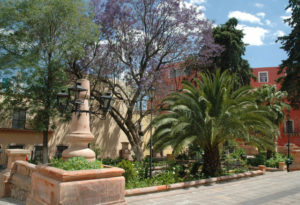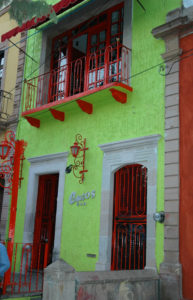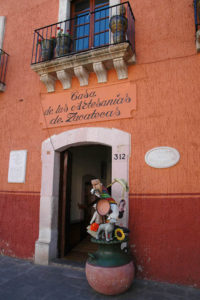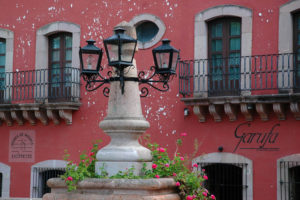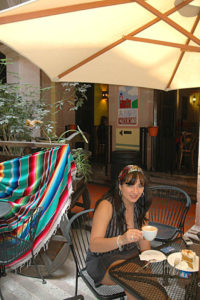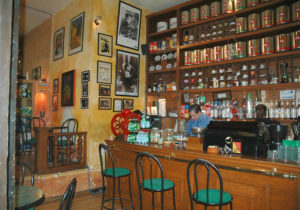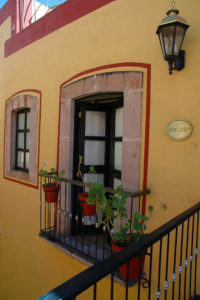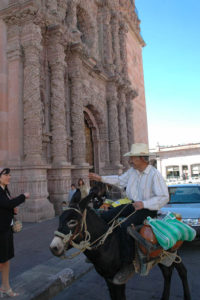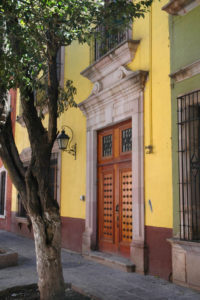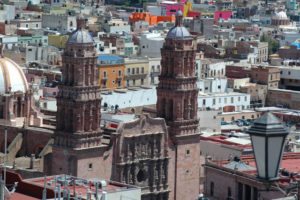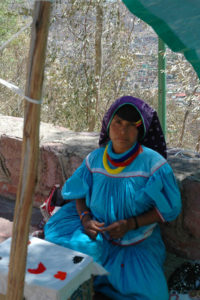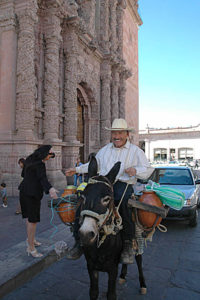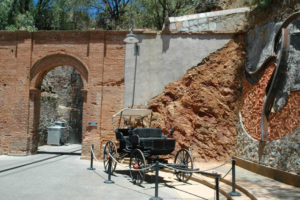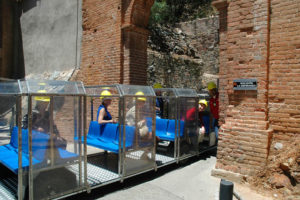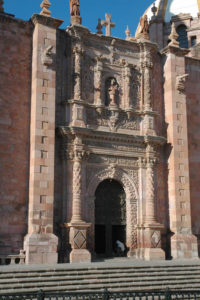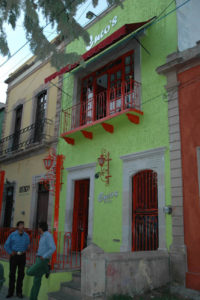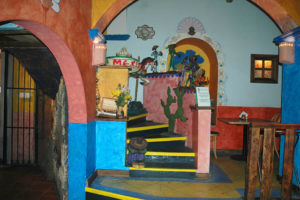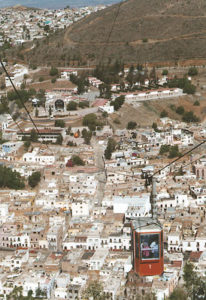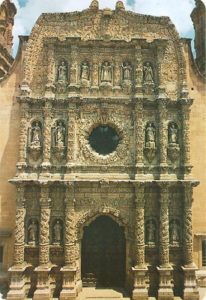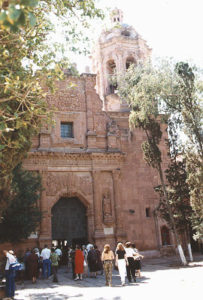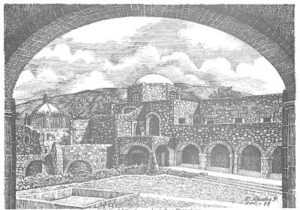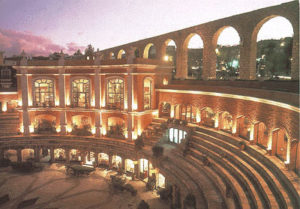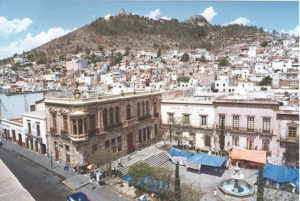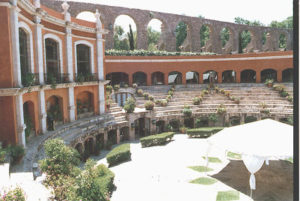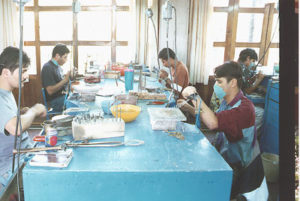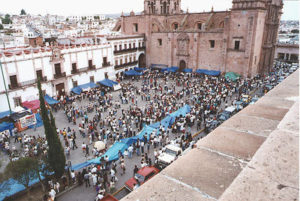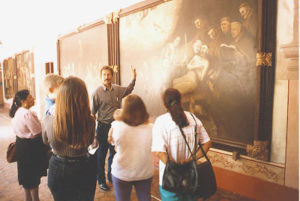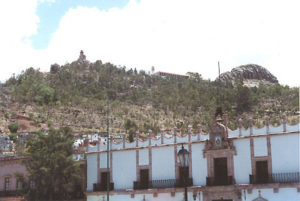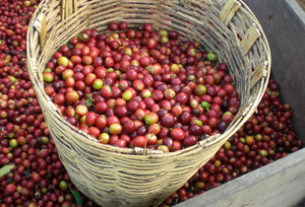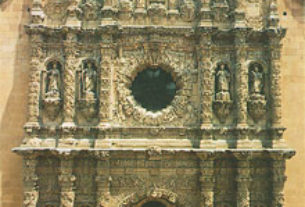“Zacatecas is the town everyone wants to go back to,” a friend said to me when I mentioned that we were going there. If not quite true, at least I know what she meant. Zacatecas was the first town we stayed in the first time we came to Mexico, back in those days when we were frankly apprehensive about coming here. The towns around the border, starting at Nuevo Laredo didn’t look too attractive. I remember lots of garbage, hungry looking dogs, delapidated billboards and roadside cafes you’d never dream of eating in. One’s biggest fear was that one might have a car problem and be stuck there. We skirted around Monterrey and got lost in Saltillo and then drove the long desolate stretch of desert between Saltillo and Zacatecas. If I remember correctly, there’s one gas station on that road – and that’s it.
So Zacatecas, some 400 miles south, came as a pleasant surprise and a relief….a charming, colonial city, and a fairly well-to-do university town with nice hotels, friendly, well-dressed people and some good attractions. In fact, on that first day, we liked it so much we decided to stay another night, even though we had an appointment in Guadalajara, most of a day’s drive further down the road. When we left, we said, “We must come back for a week-end or a long mid-week stay.”
A year or so later, we were completing the five-day drive from Canada to Mexico and, feeling road weary, we decided to treat ourselves to Zacateca’s finest, The Quinta Real, the luxury hotel which is so cleverly built around a bullring, and for an afternoon and an evening we succumbed to five-star pampering, which we loved. Next morning, as we were driving up the long winding road leading out of the valley in which Zacatecas is nestled, one of us was clearly heard to say: “We must come back for a week-end or a long mid-week stay.”
Even my Frommer’s Mexico 1996 starts off its article on Exploring Zacatecas with this statement: “Zacatecas is so picturesque that many travelers regret not having planned at least three nights here…”
So that’s what we mean when we say Zacatecas is a town everyone wants to go back to.
It’s a city with abundant charms and attractions, all of them thoroughly documented in numerous guidebooks.
One of my favorites is the Museo Pedro Coronel which houses a surprisingly eclectic art collection featuring not only examples from ancient Greece, Rome and Egypt but works by modern masters like Picasso, Miró, Dalí and Braque. Also on display are sculptures and paintings by Maestro Coronel himself.
A collection of 4,500 Mexican masks is the centerpiece of the Rafael Coronel Museum. Rafael was the younger brother of Pedro Coronel. A long chain of rooms contain the displays of exotic and colorful masks. But the best part of the Museo is simply wandering the beautiful grounds of what used to be a convent, presently undergoing restoration. Take a look around corners and down alleyways between buildings. It’s a site that contains lots of visual pleasures.
If you want to see craftsmen producing silver chains, ear-rings and bracelets – and also to make a purchase or two on your way out, visit the Centro Platero de Zacatecas. It’s a workshop and also a school for silversmiths. Zacatecas’s wealth has been founded on silver for 400 years. Originally, in pre-Hispanic times, the town, located between two mountain ranges, existed because it was the gateway between north and south. When the Spaniards arrived and discovered the rich silver deposits in 1546 the town’s fate took a different turn. Today it is still the biggest silver producer in Mexico. An association of mining engineers supports the Centro Platero, making sure of an ample supply of craftsmen for the future.
Deep in a mine. High on a mountain.
If you would like to buy your silver in an unusual setting try the Edén mine. At the entrance a train will take you 1700 feet straight into the mountain. Deep inside you’ll find two shops. One sells silver, the other sells rock and mineral samples. If you’re feeling a bit more adventurous, you can walk even further into the mine. It’s dry and nicely lit and it’s not scary. You get to look down into some quite deep gorges and they’ll even produce a waterfall for you. Keep on going and you’ll come to an elevator which takes you straight up or 200 feet to another exit.
If you’re still feeling brave it’s only a short walk up the street to El Teleférico, a cable car which swings high above the city up to Cerro de la Bufa, the mountain which dominates any aspect of Zacatecas. It’s a four or five minute ride with some wonderful views of the city nestled in a bowl below you. Don’t forget your camera. On the morning we were there the air was clear and sparkling, which is not always something you can say about a Mexican city. On the summit you’ll find an observatory, the Museum of the Taking of Zacatecas and a church, La Capilla de la Virgen of the Patrocinio, patron saint of the city – and more views.
In what other city can you go deep inside a mine and then take a cable car, all in the same morning – and never leave downtown?
Of course there’s a cathedral. This one has an incredibly ornate exterior. However, right beside it, the main square is a bit of a disappointment. It has few trees and even fewer places to sit and while away the time. However, like all other Mexican plazas, it’s still very much a people place..
And if you crave even more cultural attractions, there’s the Convento de Guadalupe with its fabulous displays of religious art ( Click for article with photos), the Regional Museo de la Historia, the Museo de F. Goitia, once a governor’s palace, and now a showcase for the works of Francisco Goitia and other Zacatecan artists.
All these places are well described in the guidebooks. They’re inexpensive and pretty easy to get to.
Actually, the most entertaining thing to do in Zacatecas is simply to go for a walk, especially in the evening. The streets are clean and tidy and nicely paved. There are very few beggars and you don’t have to wave away hordes of pedlars. The shops are worth a close inspection with their abundant displays of leather, jewellry, semi-precious stones, wood carvings and textiles. The architecture is fabulous. Many of the buildings are constructed of the pink stone quarried from the area. The stone has the effect of seeming to change color throughout the day. Each new street offers a fresh vista – a fountain, a stone carving, a unique facade, an ornate balcony decorated with plants or a set of attractive archways. It’s really a neat city, in every respect. It can be hilly in spots and the streets and alleyways wind around seemingly without rhyme or reason. Just follow your instincts and you’ll be constantly surprised and pleased. Also, be advised that Zacatecas is at an altitude of 8,000 feet. That’s a mile and a half up. So don’t get too energetic or you’ll feel the effect. And it can be cool in the evenings, so take a light sweater along.
One unique Zacatecan delight is the callejoneada , which, as it’s name suggests, is very much a street event. We met up with one while out on an evening walk. Frommer’s Mexico 1996 lists it as one of the half dozen best cultural experiences in Mexico. Anyway, it involves taking a stroll with a noisy little brass band which features a couple of exceptionally loud drummers and a man with a burro loaded with a generous supply of mezcal. What you do is sign up to accompany them and they hang a cup around your neck for the mezcal and off you go on a tour of the town, pausing frequently for drinks, singing, dancing and general merry-making that goes on until the wee small hours. It looked like fun. However, I’m getting too old for that kind of thing.
The perfect introduction to Mexico?
Zacatecas has a prosperous, settled look, more like an English cathedral town than a Mexican city. Obviously there’s a sizeable middle class there. I don’t know what they all do. I know the mines still produce silver and there’s a lot of ranching going on in the surrounding area. But these people don’t look like they’re mining or ranching. When we went to find the Centro Platero de Zacatecas we got lost in a suburb of very modern upscale houses in Fraccionamiento Lomas. Dozens of rather splendid custom built houses are under construction there, surrounding an 18-hole golf course. So somebody’s managing to prosper in these inflationary times.
The streets are busy in the evening. No one ever seems to go home. A lot of people have young children with them. I’m sure it’s perfectly safe. So if you’re a bit jittery about coming to Mexico, you couldn’t find a better place to start overcoming that nervousness. It’s the perfect introduction to a country that offers so many surprises and delights. It’s a long day’s drive from the Texas border. But plan on staying more than just one night.
We found several good restaurants in the Centro Historico district. The Quinta Real is always worth a visit – but it’s pricey, as you might expect from a grand class hotel. We were happy to find one restaurant that wasn’t mentioned in anybody’s guidebook. It was La Nueva Galicia, at Plazuela Goytia 102, featuring a wide range of Mexican dishes. I was there with five other people and everyone enjoyed the experience. We also found a Greek ice-cream parlor called Café Nevería Acrópolis where we splurged on baclava and banana splits. (That’s right – a Greek ice-cream parlor!).
Our favorite place, however, was La Cuija, where the owner, who is a dead ringer for Lou Costello, (Remember Abbott and Costello?) and just as much a comedian in his own right, chats with all the diners and, at the merest drop of a sombrero , will try to sell you an extravagantly autographed copy of his cookbook. It’s called Cocina Regional . His name is Filiberto Enriquez Perales. He’ll ask 180 pesos for it, but you can get him down to 150 pesos or perhaps even less. It’s an attractive place. The waiters are all very personable and friendly – cloned, possibly, from Senor Perales. The cuisine is what you’d expect from someone who’s written a Mexican cookbook. We were all more than delighted with our chicken mole , grilled huachinango (a fish) and lomo zacatecano (broiled pork with chile sauce).
Zacatecas just doesn’t get as many tourists as a lot of other Mexican destinations. When I mentioned this to a friend in Ajijic she said: “Yes, Zacatecas is just like San Miguel de Allende – without tourists.” That’s not a remark that should make the Zacatecas Tourist Department feel very happy. This might be because Zacatecas is small and some distance from other colonial cities. It may also be because, as I mentioned earlier, Zacatecas is seen by many people as just an overnight stop on the way south. I suspect, too, a big reason is it doesn’t promote itself as much as many other cities – like Oaxaca, for instance, which really works at making tourism a lucrative industry. There are two tourist offices in Zacatecas but the one I visited seemed to exist only to hand out pamphlets. The lone employee there didn’t speak a word of English and my Spanish wasn’t good enough to allow me to phrase the questions I wanted to ask. She wouldn’t have known the answers anyway.
In Oaxaca I clearly recall going to the Secretaría for Tourism Development with a bunch of questions and being given all the information I asked for. Also, I remember the very detailed two-page survey my wife was asked to fill out about tourism one night in the zócalo in Oaxaca. From the information I was given it was quite apparent that officials in that state make good use of the data they gather to promote their area. In my humble opinion, Zacatecas needs to make the same sort of effort.
However, please don’t let any of this criticism deter you. I just hope I’ve conveyed the impression that Zacatecas is a town well worth visiting. I should tell you, too, that as we were leaving on this most recent visit, my wife was clearly heard to say: “Why don’t we come back for a few days at Christmas.” I think we will, too.

